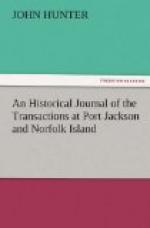There was reason to conjecture, from this difference on the opposite tacks, that the leak was somewhere about the starboard bow, and near the surface of the water, and if it proved so, I had a hope that we might, the first moderate weather, with smooth water, be able to come at and stop it. I was the more sanguine in this expectation, as the carpenter, in a few days after, discovered it to be under the after part of the fore-channel, a little below the surface of the water; and seemed to think it proceeded from one of the butt-bolts being corroded by the copper, which I now understood had never been taken off since the ship’s being first sheathed, which was now more than eight years.
On the 6th, the weather cleared up, and both Mr. Bradley and myself had a few distances of the sun and moon, by which our longitude was 157 deg. 10’ east, by the time-keeper 156 deg. 55’ east, and by account 156 deg. 17’ east; the latitude 34 deg. 49’ south; variation per Azimuth 11 deg. 40’ east. At noon, the wind got round to east and east by north, with which I steered south-south-east; still favouring our endeavours to get to the southward; it next came to north-east and north, and in latitude 40 deg. 33’ south, it came to north-west, but the weather still continued squally and unsettled. As the weather began now to be rather cold, and as in the track I meant to prosecute my voyage by I might expect to have it considerably colder, and consequently the ship’s company would require a shift of cloathing, slops were served to all who stood in need of them.
On the 9th, we were near as far to the southward as Van Diemen’s Land, or South Cape of New Holland; and the wind being apparently settled in the south-west quarter, I steered a course for the south cape of New Zealand. From Port Jackson to Van Diemen’s Land we had run parallel to the coast, at the distance of 60 leagues from it, and have not seen any thing; so that we may venture to say, that there are no islands lie off that part of the coast, at the above distance from it. On the afternoon of this day (9th) we had several good setts of distances of the sun and moon, by which our longitude was 157 deg. 26’ east, by the time-keeper 157 deg. 19’ east, and by account 157 deg. 48’ east; the latitude 43 deg. 30’ south; the thermometer was now 57 deg..
On the 12th, we passed the south cape of New Zealand, but the weather being very hazy and squally, we did not attempt to make it, but kept a degree and a half to the southward of it; here we met with vast numbers of birds of various kinds, mostly aquatic, such as albatrosses, pentada birds, divers, peterels, and a variety of gulls; some of a kind I had not before seen during the voyage, very large, of a dark brown or mouse colour; and another sort not quite so large, with a white body, dark wings, and the head of a light blue or lead colour: much sea-weed was also seen here in very large patches.
We now had the wind fresh from the north-west quarter, with frequent squalls, attended with rain, and the weather cold. We found the variation of the compass 40 leagues south-south-east from the south cape of New Zealand, to be 16 deg. 54’ east. Mr. Worgan, the surgeon, having recommended the essence of malt to be served at this time to the ship’s company, a certain quantity of wort was made every morning, and a pint served to each man.




